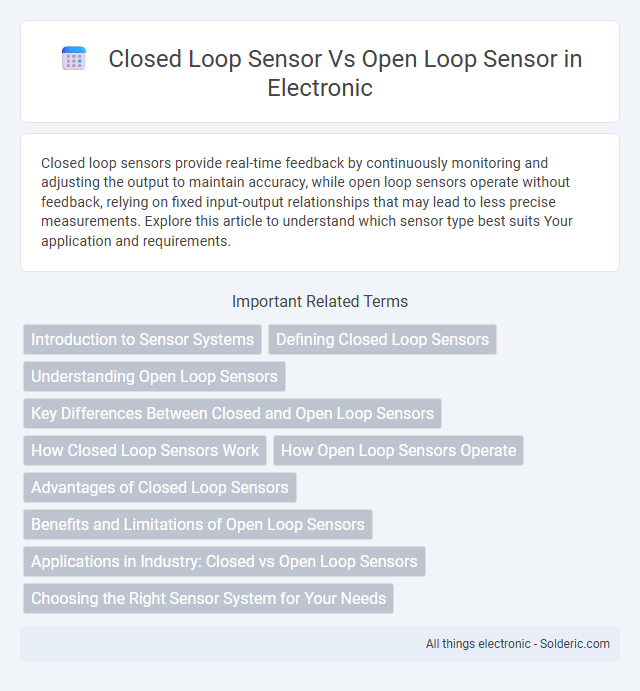Closed loop sensors provide real-time feedback by continuously monitoring and adjusting the output to maintain accuracy, while open loop sensors operate without feedback, relying on fixed input-output relationships that may lead to less precise measurements. Explore this article to understand which sensor type best suits Your application and requirements.
Comparison Table
| Feature | Closed Loop Sensor | Open Loop Sensor |
|---|---|---|
| Feedback Mechanism | Provides real-time feedback for corrective action | No feedback; output relies on input signal only |
| Accuracy | High accuracy due to continuous correction | Lower accuracy; prone to errors and drifts |
| Complexity | More complex with additional components | Simple design, fewer components |
| Cost | Higher due to complexity and components | Lower cost, simpler manufacturing |
| Response Time | Slower due to feedback loop processing | Faster response time |
| Examples | Encoder-based position sensors, Hall effect sensors with feedback | Basic temperature sensors, photodiodes without feedback |
Introduction to Sensor Systems
Closed loop sensors continuously monitor the output and adjust their input based on real-time feedback, ensuring high accuracy and stability in sensor systems. Open loop sensors operate without feedback, providing measurements based solely on the input signal, which can lead to less precise control in dynamic environments. Closed loop sensor systems are preferred in applications requiring precise regulation, such as robotics and industrial automation, due to their ability to self-correct and maintain consistent performance.
Defining Closed Loop Sensors
Closed loop sensors incorporate feedback mechanisms to continuously monitor and adjust the system output, ensuring precise control and higher accuracy in real-time applications. Unlike open loop sensors, which operate without feedback and provide fixed output regardless of any changes in the system, closed loop sensors dynamically respond to environmental or operational variations. This feedback-driven design makes closed loop sensors essential in applications requiring stability, error correction, and enhanced performance.
Understanding Open Loop Sensors
Open loop sensors measure a physical quantity without feedback to adjust their output, making them simpler and more cost-effective but less accurate compared to closed loop sensors. These sensors rely solely on the input signal and lack the ability to correct errors caused by environmental changes or system variations. Your choice of open loop sensors can be suitable for applications where precision is less critical and cost-efficiency is a priority.
Key Differences Between Closed and Open Loop Sensors
Closed loop sensors provide real-time feedback by continuously monitoring output to adjust system performance, ensuring higher accuracy and stability. Open loop sensors operate without feedback, relying solely on predefined input signals, which can result in less precision and potential drift over time. Closed loop systems are preferred in applications requiring precise control, while open loop sensors suit simpler, cost-effective scenarios.
How Closed Loop Sensors Work
Closed loop sensors operate by continuously monitoring the output signal and comparing it to the input or reference signal to provide real-time feedback. This feedback mechanism allows the sensor to automatically adjust and maintain precise control over the process or system. Your application benefits from increased accuracy, stability, and responsiveness due to this constant error correction.
How Open Loop Sensors Operate
Open loop sensors operate by directly measuring a physical parameter without feedback to adjust the sensor's performance, relying solely on the initial input signal for output. These sensors typically detect variables such as temperature, pressure, or light intensity, converting the input directly into an electrical signal for monitoring purposes. Without corrective feedback, their accuracy depends on stable environmental conditions and precise calibration during manufacturing.
Advantages of Closed Loop Sensors
Closed loop sensors offer precise feedback control by continuously monitoring output and adjusting inputs, resulting in higher accuracy and stability compared to open loop sensors. Your system benefits from reduced errors, enhanced reliability, and improved performance in dynamic environments. These advantages make closed loop sensors ideal for applications requiring fine-tuned control and consistent operational efficiency.
Benefits and Limitations of Open Loop Sensors
Open loop sensors offer simplicity and cost-effectiveness by directly converting input signals without feedback mechanisms, making them suitable for applications with stable and predictable environments. However, their lack of feedback limits accuracy and responsiveness in dynamic conditions, leading to potential drift and reduced reliability over time. Open loop sensors are best utilized in scenarios where precision is less critical and environmental changes are minimal.
Applications in Industry: Closed vs Open Loop Sensors
Closed loop sensors are extensively used in precision industrial applications such as robotics, CNC machines, and automated assembly lines where real-time feedback and high accuracy are critical for maintaining system stability and performance. Open loop sensors find applications in simpler processes like basic temperature monitoring, flow measurement, or humidity detection where cost efficiency and ease of installation outweigh the need for continuous feedback. Industries such as automotive manufacturing, aerospace, and process control rely heavily on closed loop sensors for enhanced control, while HVAC systems and water treatment plants often utilize open loop sensors for straightforward monitoring tasks.
Choosing the Right Sensor System for Your Needs
Closed loop sensors provide real-time feedback by continuously monitoring and adjusting system performance, offering higher accuracy and reliability compared to open loop sensors, which operate without feedback and are simpler and more cost-effective. Your choice depends on the application requirements: closed loop is ideal for precision control and systems demanding stability, while open loop suits basic monitoring where cost and simplicity are priorities. Understanding the trade-offs in complexity, responsiveness, and accuracy helps you select the optimal sensor system tailored to your specific operational needs.
closed loop sensor vs open loop sensor Infographic

 solderic.com
solderic.com